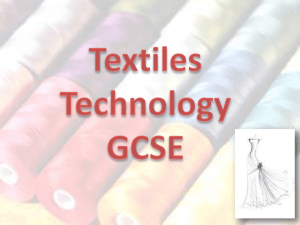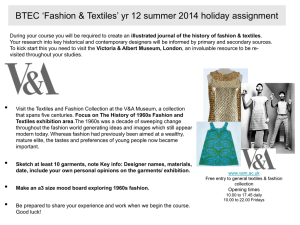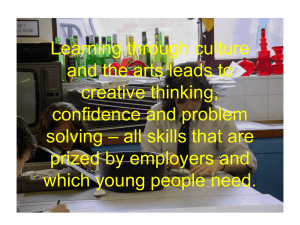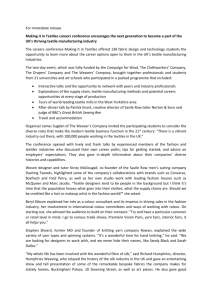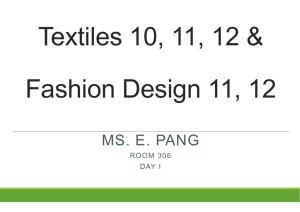Textiles Sixth Form Induction work 2014.doc
advertisement
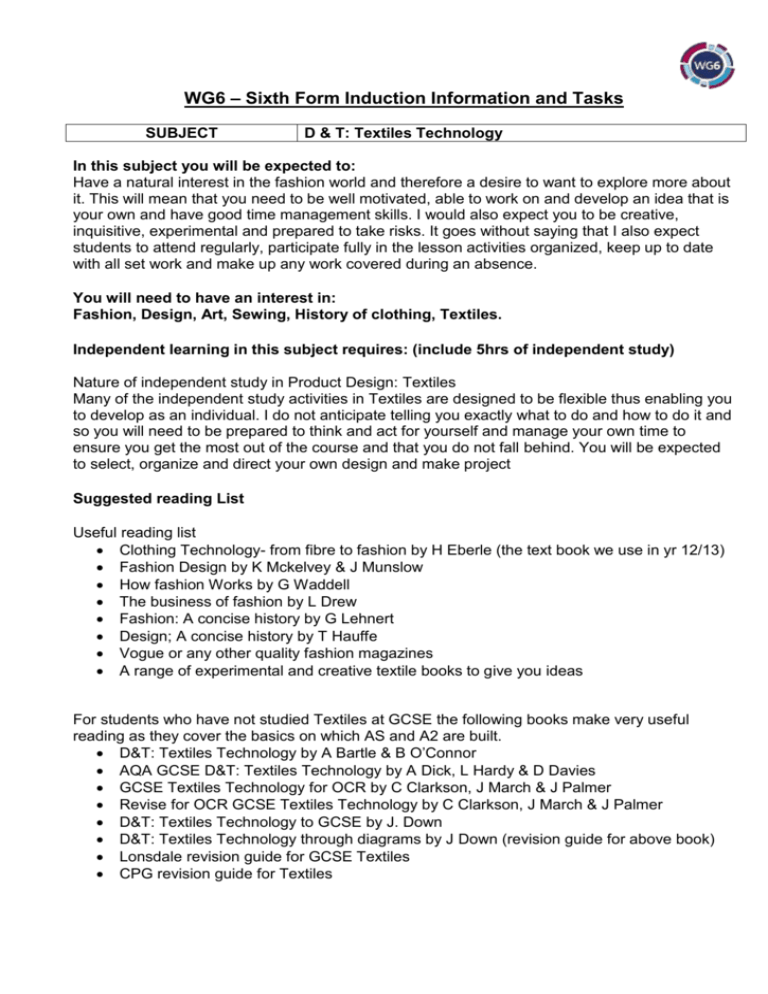
WG6 – Sixth Form Induction Information and Tasks SUBJECT D & T: Textiles Technology In this subject you will be expected to: Have a natural interest in the fashion world and therefore a desire to want to explore more about it. This will mean that you need to be well motivated, able to work on and develop an idea that is your own and have good time management skills. I would also expect you to be creative, inquisitive, experimental and prepared to take risks. It goes without saying that I also expect students to attend regularly, participate fully in the lesson activities organized, keep up to date with all set work and make up any work covered during an absence. You will need to have an interest in: Fashion, Design, Art, Sewing, History of clothing, Textiles. Independent learning in this subject requires: (include 5hrs of independent study) Nature of independent study in Product Design: Textiles Many of the independent study activities in Textiles are designed to be flexible thus enabling you to develop as an individual. I do not anticipate telling you exactly what to do and how to do it and so you will need to be prepared to think and act for yourself and manage your own time to ensure you get the most out of the course and that you do not fall behind. You will be expected to select, organize and direct your own design and make project Suggested reading List Useful reading list Clothing Technology- from fibre to fashion by H Eberle (the text book we use in yr 12/13) Fashion Design by K Mckelvey & J Munslow How fashion Works by G Waddell The business of fashion by L Drew Fashion: A concise history by G Lehnert Design; A concise history by T Hauffe Vogue or any other quality fashion magazines A range of experimental and creative textile books to give you ideas For students who have not studied Textiles at GCSE the following books make very useful reading as they cover the basics on which AS and A2 are built. D&T: Textiles Technology by A Bartle & B O’Connor AQA GCSE D&T: Textiles Technology by A Dick, L Hardy & D Davies GCSE Textiles Technology for OCR by C Clarkson, J March & J Palmer Revise for OCR GCSE Textiles Technology by C Clarkson, J March & J Palmer D&T: Textiles Technology to GCSE by J. Down D&T: Textiles Technology through diagrams by J Down (revision guide for above book) Lonsdale revision guide for GCSE Textiles CPG revision guide for Textiles Useful Websites: Examples of Independent Study tasks: Independent study tasks to be set over the year will include: Term1 Experiment with a range of materials such as plastic carrier bags, bubble wrap and sweet wrappers to produce samples of original and creative fabrics. This will involve knitting, weaving and bonding. Practice using the sewing machine to produce samples of techniques such as quilting, appliqué and free machine embroidery. Research into a named natural fibre and preparation of an information pack which can be used to inform the rest of the group. Essay questions from past examination papers to support the topics covered in theory lessons. Research into London Fashion Week Research into and produce a poster on a decade of fashion. Research into chosen coursework design brief. Term 2 Conduct a product analysis on a piece of textile clothing/accessory. Familiarization with how to read, interpret and follow a paper pattern. Dart manipulation activity. Research into body scanning technology. Research into a named synthetic fibre and preparation of an information pack which can be used to inform the rest of the group. Investigation into smart and modern materials. Essay questions from past examination papers to support the topics covered in theory lessons. Development of design work linked to coursework. Term 3 Look at a range of textile products and record how texture has been created. Experiment with fabric to create interesting surface textures using techniques such as pleats, gathers, ruffles, tucks, smocking and flounces. Modelling and manufacture of final product. (practical work) Term 4 Investigation work into different types of components available. Use CAD software (2D Design, Illustrator, Photoshop etc) to create design work. Testing and evaluating manufactured product. Term 5 Revision strategies Mind maps of topics covered to aid revision. Practice examination questions. Reading around topics to expand knowledge of the subject. Term 6 A2 course starts Research into past and current designers and design movements enabling a power point presentation to be given to the rest of the group. Information on Coursework deadlines Coursework portfolio will be produced throughout the year with deadlines approximately every month. Main project deadline will be at the end of March. Written examination will be in June Future Career aspirations linked to this subject are: Fashion designer, fashion journalist, textile print designer, fashion buyer, design technology teacher, pattern drafter, production manager, fashion retail manager, costume designer, set designer for theatre, interior designer. Induction Task & Success Criteria 1. Research into how fabric can be manipulated to create different textures. This could include notes and diagrams of methods, technical samples and photographs and will result in a better understanding of how fabric can be used to create interest without actually using traditional surface decorative methods. 2. Select one of the following themes and produce 2/3 A3 sheets of images which you have recorded from direct observation. These should include a number of different media (ink, paint, rubbings, photographs, charcoal, pencil, fabric etc) and should include some close up images of your chosen object. Themes to choose from are: Flora & Fauna, SeaWorld, Architecture or Time and Motion. 3. Produce a power point on your favourite designer (fashion or interiors). This should explain to your audience (other fashion and design students) a little bit about the designer’s background and their career path, what their inspiration is, who they have subsequently inspired if they are a well-established designer, some examples of their work and why you like their work. 4. The twentieth century was known for distinctive “Decades of Style”, where styles, fashions and images reflect each of the decades. Select one of these decades and describe the images, influences, textiles and fashions of that time. Make reference to some of the key designers of the period and discuss the impact they have had. This is an essay style of question and the response should be 2/ 3 A4 pages of type. Additional requirements for the course 5. Any student who is not able to use a sewing machine confidently should practice throughout the holiday to ensure that by the start of the course they can thread it up and use it to stitch in a straight line, around curves and turn a corner. They should also be able to stitch using zigzag stitch. 6. I would also like students to collect fabrics. These can be unusual ones, ones that colour coordinate, pieces from old clothing, and decorative ones. Bring these to your first lesson. Deadline First lesson in September. You will be assessed against these assessment grade descriptors for the first 4 AS Textile induction tasks An ‘A’ grade student will Use a wide range of sources of information. Make a real attempt to find out information which is new to them and is significantly more advanced than knowledge learnt at GCSE. Produce imaginative and feasible ideas as a result of experimentation. Demonstrate a high level of making skills and accuracy using a varied range of materials. Demonstrate a wide range of different skills. Demonstrate a good understanding of the potential applications of fabric manipulation methods researched. Be able to communicate information effectively and creatively. Be able to understand and use correct technical vocabulary clearly and fluently. Be able to produce an informative and professional Power Point Presentation. A ‘C’ grade student will Use a range of sources of information. Find out some information which is new to them and is slightly more advanced than knowledge learnt at GCSE. Produce a range of feasible ideas showing some use of imagination. Demonstrate a good level of making skills at above average level of accuracy. Demonstrate a range of different skills. Demonstrate a fair understanding of the possible applications of fabric manipulation methods researched. Be able to communicate moderately complex ideas clearly. Be able to understand and use correctly, some technical vocabulary. Be able to produce an interesting and coherent Power Point Presentation. An ‘E’ grade student will Use very few sources of information. Present information which is unlikely to be new to them and is no more advanced than knowledge which should have been learnt at GCSE. Produce simple ideas that lack imagination. Demonstrate some ability to manipulate a limited range of materials using basic techniques with some accuracy. Demonstrate a limited range of different skills. Demonstrate a limited understanding of possible applications of fabric manipulation methods researched. Be able to communicate information at a basic level with little detail. Demonstrate limited use and understanding of subject specific vocabulary. Be able to produce a Power Point Presentation detailing some useful information.
